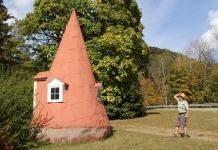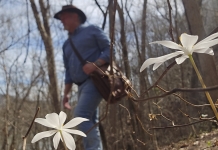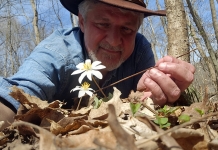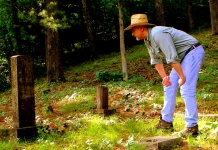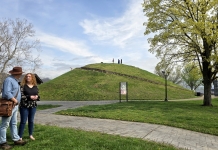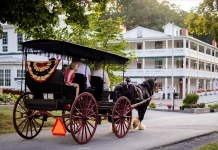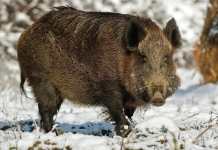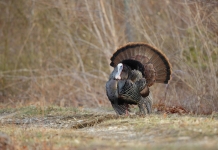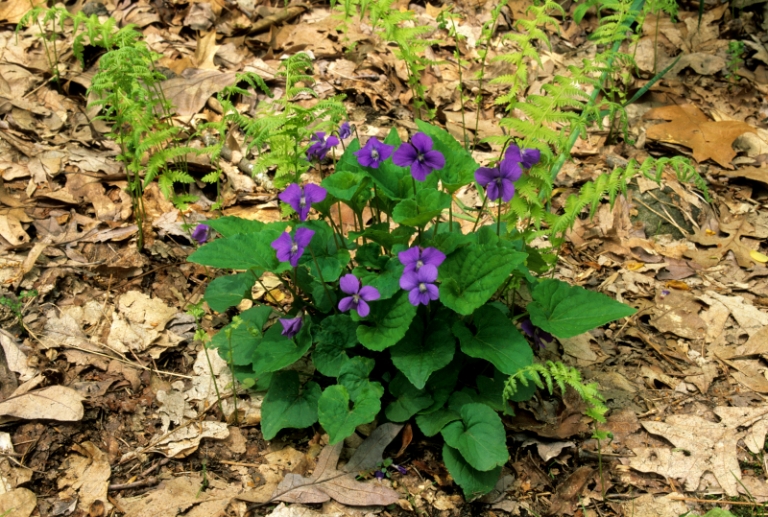
I hunt for undomesticated plants. Even though I have a substantial vegetable garden, which supplies my family with a steady supply of fresh, frozen, and canned corn, beans, onions, carrots, lettuce, spinach, potatoes, tomatoes, I still forage for wild salad plants.
I can’t imagine doing otherwise. Because it's fun, I do what one person described to me as “unnecessary.” Wild plants are very nutritious, they taste good, and they are free. If variety truly is the spice of life, then why not let a wild plant spice up my life a bit?
Wild food salad plants can be divided into three categories—main ingredients, substitutes, and garnishes. A "main ingredient" plays the same role as lettuce or spinach would in most salads. My favorite wild food to use as a main ingredient is chickweed.
According to the Flora of West Virginia, the name “chickweed” can be applied to nine different plants representing five genera. The differences in the texture, taste, and appearance of these different chickweeds are important. Some are fuzzy while others are smooth. Their taste varies from tasteless to slightly bitter to slightly sweet. Some are larger and more common than others, but none has ever been reported to be poisonous.
Two chickweeds are abundant, slightly sweet, and tender. Common chickweed (Stellaria media) is considered to be a weed and occurs in abundance in sunny cultivated and disturbed areas. My vegetable garden is besieged by it.
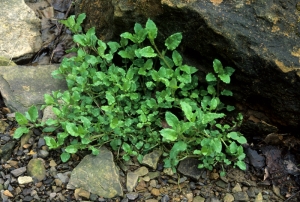
The best way to collect this chickweed is to take a piece of clear plastic—I use a six-by-six-foot section—lay it on top of the garden ground in mid-to-late winter, cover the edges with heavy stones to prevent the plastic from blowing away, and then wait. As the sun begins to warm the earth in early spring, the chickweed seeds germinate and sprout all over the garden, though a greenhouse effect created where the plastic was placed causes the chickweed there to grow much faster. In fact, the chickweed grows up and out so thickly that it pulls the plastic out from under the rocks. Now you have a main salad ingredient that can be picked by the handful. Leaves, stems, and flowers are all edible and tender.
Great chickweed (Stellaria pubera) grows in shaded, rocky areas throughout West Virginia. Its lower leaves are much larger than those of the common chickweed and it’s easy to collect. Several wooded hillsides near my home are nearly covered with this chickweed. As with the common chickweed, all above-ground parts are edible and are excellent sources of Vitamin C.
Violet leaves are a wild food main salad ingredient. A half-cup of violet leaves provides the Vitamin C of four oranges and more than the recommended daily requirement of Vitamin A. If you aren’t familiar with the green parts of the plant (Viola sororia), wait for the violet-blue flowers to appear, then memorize the leaf shape so you can collect them any time of the year. The leaves of the white violets are just as edible.
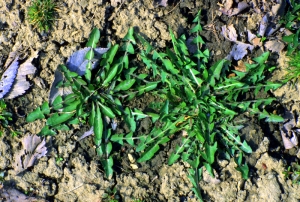
What wild plant has more Vitamin A than any other plant in the world? More Vitamin C than any supermarket citrus fruit? And more calcium than whole milk? If you answered dandelion, you are correct. Eating dandelions (Taraxacum officinale) is not a new idea. Many people are familiar with wilted dandelion greens. However, to be successful in creating a salad with dandelion as the main ingredient, you have to be discriminating. If you collect leaves only from plants that have not yet formed flower buds, they are much less bitter. My favorite part of the dandelion is the “crown”—the small, tender white section where the root and leaves join together. I find it well worth the extra effort to collect dandelion crowns for salad use.
Certain domestic vegetables used in salads have wild food counterparts. Three salad substitutes I like to use are wild garlic and ramps substituted for onions, unopened milkweed flower buds for broccoli, and cattail center sections for cucumber.
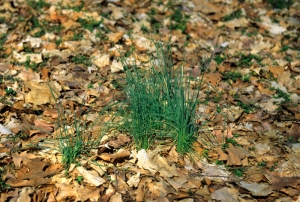
Wild garlic (Allium vineale) is a cool-weather plant that prefers the chill of late winter and early spring to the warmth that accompanies the advent of summer. A garlic odor can encompass the neighborhood as lawnmowers begin to deal with rapidly growing grass which is interspersed with similar-looking wild garlic. When the green garlic tops are cut, the bulbs and roots remain alive and healthy. As the season progresses and days become longer with warmer temperatures, wild garlic seems to disappear. All the above-ground parts wither and fade away once their job is finished. The roots now have enough of the sun’s energy stored away for flower and fruit production, which begins in late May. All parts of wild garlic are edible and onion-like.
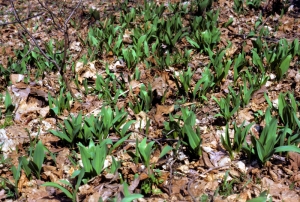
April 14 is what I call “ramp day” in northern West Virginia. At this time of year, ramps (Allium tricoccum) are nearly full-grown. The leaves are bright green, and they are taller than other spring plants. They are very obvious and usually grow in patches. When you find a plant in a woodland with a broad-leaf similar to that of a tulip and a strong onion smell and taste, you have found a ramp. Nothing else matches that description.
Be careful to mark the exact location of ramp patches. By the first day of summer, the ramps seem to have disappeared. The leaves have withered, fallen off, and are mostly decayed. Only the bulb-like roots persist. This root is available all year round if you can remember where it is buried. Leaves, stems, and roots are all edible and, to many people, are far superior to domestic onions. One good rule to remember about onion substitutes—a little goes a long way. Both wild garlic and ramps are very potent. If the taste of raw ramps is too potent for you, a short sauté tones down the wildness of these onions.
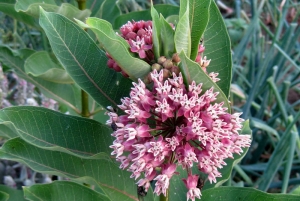
Common milkweed (Asclepias syriaca) is an excellent broccoli substitute. The unopened flower-bud clusters of the common milkweed look like green balls the size of tennis balls and are composed of many smaller green balls the size of peas. They first appear near the end of spring. If they are gathered early in the season while they are still green, boil them for 10 minutes, drain, and discard the water, add new water, and boil again for five minutes. This process eliminates the bitterness.
But I usually try to wait a while to collect milkweed broccoli. I keep a close watch on nearby stands so I can collect it at the “pinking” stage. At this stage, the still-closed buds take on the pinkish color the flowers will be. The goal is to collect milkweed broccoli as near to flowering time as possible. If it is picked just before flowering, after just one boil most of the bitterness will be gone and the flower buds will have a special sweetness. This sweetness is from the nectar that has been produced for the “grand opening” being planned for the local flower pollinators. Mixed with other salad ingredients, it is delicious.
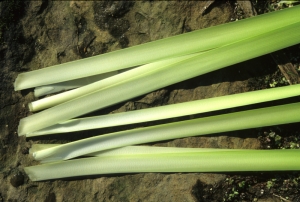
Since I love cucumbers, the broadleaf cattail (Typha latifolia) is a wild food substitute essential to my salads. I have served it to dozens of people at edible wild food classes and everyone likes it. The only thing these folks are not sure of is how to describe what it tastes like. Cucumber and watermelon are the tastes most often suggested.
Cattails are best collected in the spring when they are two to four feet tall. Cut them off at or just below the water-level. Peel back the outer green plant material then the whitish-green material until you get to the pure white tender center section. Cut the “cucumber” into small pieces, and add it to your salad.
A garnish is added to a salad in small quantities to beautify or to enhance the taste or to do both. Edible wildflowers really embellish a salad. Redbuds, blue violets, and black locusts produce flowers I use most often to add color. The nectar in all of these flowers adds a pleasing sweetness to a salad.
Wild plants I recommend to add a “zing” to a salad are all in the mustard family. Watercress and any mustard in the genus Cardamine are excellent garnishes.
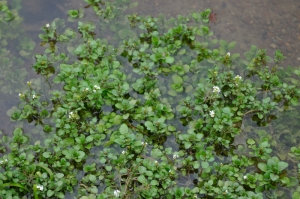
Watercress (Nasturtium officinale) is in the genus Nasturtium, a word derived from the Latin “nasus tortus” or “twisted nose,” in reference to the pungent odor. This pungency is delicious when mixed with other milder ingredients. Watercress is a water-loving plant and is often found in large quantities. It is important to collect your watercress, or any other water-associated plants, from unpolluted areas.
A stream near my home is beautifully choked with watercress for about 100 yards. Unfortunately, the same stream is in the middle of a cow pasture, so the risk of getting a parasite from the dirty water is too great to allow collecting there.
Purple cress (Cardamine douglassii), bulbous cress (C. bulbosa), Pennsylvania bittercress (C. pensylvanica), hairy bittercress (C. hirsute), and mountain watercress (C. rotundafolia) are cardamines which I collect and eat often.
Purple cress is a mid-spring plant that grows along streams in deep, wooded ravines. The leaves are small, but keep in mind that this plant is being used as a garnish and few leaves are needed to spice up your salad.
Bulbous cress is also found in wet places. Its flowers are white. I find it in wet meadows and spring-fed areas where the water is usually clean. Bulbous cress has a peppery taste reminiscent of horseradish.
The other three cardamines are mildly pungent and are among the most delicious and common of all the edible wild mustards, especially during late winter and early spring. Mountain watercress grows in or near water, often forming large clumps. Of all the edible wild foods, it is probably the most overlooked. And that is surprising since it is so appetizing.
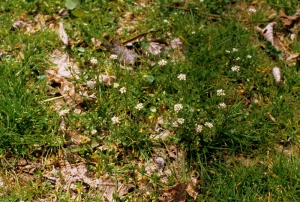
The most common cardamine is hairy bittercress. It is virtually everywhere in Brooke County where I live, especially in my lawn and in my vegetable garden areas. Pennsylvania bittercress has long been considered an excellent substitute for European watercress. Every damp woodland I enter has this plant in or near any slow-flowing streams or seeps trickling into the streams. It is easy to find and collect, and it tastes great.
What more could a person want from a food plant? Well, there is one more thing we get from plants in the mustard family whether we want it or not—nutrition. Vitamins A, C, and B are abundant in these cruciferous vegetables.
More often than not, salads in my home consist of domestic vegetables and one or two wild food salad plants. Anyone interested in edible wild plants doesn’t need to learn everything at once. Begin with the most common, like the common chickweed, dandelion, wild garlic, common blue violet, and hairy bittercress, and then progress from there.
Before collecting any wild edibles, be sure you learn to identify plants using one of the many wildflower field guides that are available. Before long, if you desire, you may be eating salads consisting of nothing but wild plants.
For more information on edible wild plants in West Virginia, order a copy of Bill and Bev Beatty’s Wild Plant Cookbook.
Sign up to receive of FREE copy of West Virginia Explorer Magazine in your email weekly. Sign me up!







